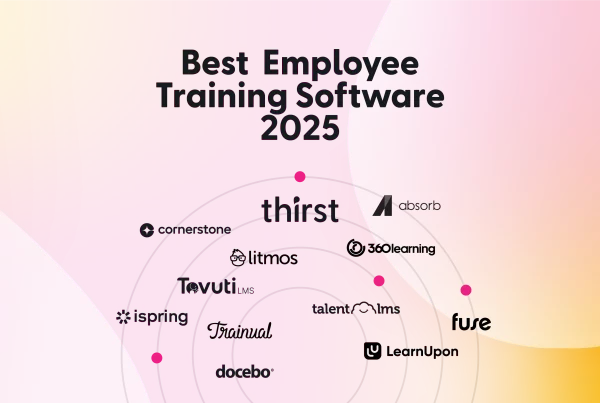As we move through 2025, the dynamics of the working world continue to evolve with rapid momentum. At Thirst, we understand that trying to keep up with the latest trends, processes, and ideas can be hard work. 🤯
So whether you’re an HR professional looking to revamp your company’s training initiatives or a business leader seeking innovative ways to empower your team, join us as we explore the ins and outs of creating a robust learning and development strategy that aligns seamlessly with the demands of the current 2025 landscape.
Let’s get into it.👇
What does a successful L&D strategy look like in 2025?
In 2025, a successful Learning and Development (L&D) strategy is characterised by three pillars.
- Agility. 🚀
- Technology integration. 🤖
- Personalised learning experiences. 🧑🏼🤝🧑🏼
Later in this article, we’ll be sharing how to execute a successful L&D strategy in 2025, but first, let’s take a look at the key reasons why your organisation needs a powerful L&D Strategy.
What are the benefits of a robust L&D strategy?
Skill Enhancement 🧑🏻🏫
In today’s dynamic business environment, skills quickly become outdated.
An L&D strategy ensures that employees continually acquire new skills, keeping them at the forefront of industry trends and technology advancements.
Learn more about Skills Development
Employee Engagement 🗣️
Offering learning opportunities demonstrates a commitment to employee development, leading to increased job satisfaction and engagement.
Engaged employees are more likely to be productive, innovative, and loyal to the organisation.
Learner Engagement: What It Is and Tips to Improve It
Talent Retention & Employee Morale 😃
Employees value organisations that invest in their growth.
A well-crafted L&D strategy can serve as a powerful retention tool by providing a clear path for career development, reducing the likelihood of talented individuals seeking opportunities elsewhere.
Adaptation to Change 🛣️
As industries evolve, organisations must adapt.
An L&D strategy fosters a culture of continuous learning, empowering employees to adapt to changes in technology, market dynamics, and organisational structure.
Increased Productivity ✅
Employees with up-to-date skills and knowledge are more efficient and productive.
L&D initiatives ensure that individuals are equipped with the tools and expertise needed to perform their roles effectively, ultimately contributing to organisational productivity.
Competitive Advantage🥇
Organisations that prioritise employee development gain a competitive edge.
A skilled and knowledgeable workforce is a valuable asset that enhances an organisation’s ability to innovate, adapt, and outperform competitors.
Now that we’ve established the main benefits of a strong L&D strategy let’s get into how to create one (that really works!) 🙌
How to develop an effective L&D strategy in 2025
1. Conduct a needs analysis to identify organisational goals and objectives 🥅
Conducting a thorough needs analysis helps you understand the skills and competencies required to meet your goals.
How to do it
Identify performance gaps and areas where learning and development can make a meaningful impact.
2. Align with Business Objectives 📈
Ensure your proposed L&D strategy aligns closely with the overall business strategy and objectives.
How to do it
Identify key performance indicators (KPIs) that can measure the success of the L&D initiatives in contributing to organisational goals.
3. Engage Stakeholders 👩🏽💼🧑🏻💼
Involve key stakeholders, including executives, managers, and employees in the development process to ensure they are all on board with the strategic direction you’re headed in.
How to do it
Gather input on current challenges, skills gaps, and training needs from various departments and levels within the organisation.
4. Define Learning Objectives 📊
Clearly articulate the learning objectives that support organisational goals to avoid any grey areas and to ensure everyone is singing from the same hymn sheet.
How to do it
Specify the skills, knowledge, and behaviours that employees should acquire through the L&D initiatives.
5. Identify Your Target Audience 🧑🏻
Defining the target audience for the L&D programmes and considering different roles, departments, and levels within the organisation helps to ensure your goals are relevant to the right people.
How to do it
Tailor the content and delivery methods to meet the specific needs of each audience.
6. Choose Learning Methods and Modalities 💻
Select appropriate learning methods and modalities based on the nature of the content and the preferences of the target audience.
How to do it
Consider a mix of in-person training, e-learning, on-the-job training, mentoring, and other relevant approaches.
7. Develop Content and Resources 📚
Create or curate learning content that aligns with the defined learning objectives.
How to do it
Develop resources, such as training materials, online modules, videos, and job aids to support the learning process.
8. Implement Delivery Mechanisms 🖥️
Implement the chosen delivery mechanisms through a Learning Experience Platform, workshops, virtual classrooms, or other platforms.
How to do it
Ensure that the delivery methods are accessible and user-friendly for the target audience.
How to choose a learning platform
9. Promote Engagement and Participation 🤝🏻
Design programmes that actually engage and motivate participants.
How to do it
Encourage active participation through interactive elements, discussions, case studies, and practical exercises.
10. Incorporate Feedback Loops ➿
Establish mechanisms for gathering feedback throughout and after the learning interventions.
How to do it
Use feedback to assess the effectiveness of the L&D initiatives and make continuous improvements.
Learning Loops: How to Use Them to Drive Learner Engagement
11. Measure and Evaluate 📊
Develop metrics and key performance indicators to measure the success of the L&D programs.
How to do it
Evaluate the impact on individual performance, team dynamics, and overall organisational outcomes.
12. Iterate and Improve 📶
Use evaluation data and feedback to iterate and improve the L&D strategy continually.
How to do it
Stay responsive to changing business needs, emerging trends, and evolving learning preferences.
13. Integrate with Performance Management 🗒️
Align L&D initiatives with the organisation’s performance management processes.
How to do it
Ensure that any new learning and development efforts are integrated into performance evaluations and career development plans.
14. Create a Learning Culture 🧠
Foster a culture of continuous learning within the organisation. Define to your workforce why this is a good thing for everyone.
How to do it
Encourage employees to take ownership of their learning and career development. Give them space to put time into their new skills.
15. Communicate and Celebrate success 🏆
Communicate the achievements and success stories resulting from the L&D initiatives.
How to do it
Celebrate milestones and recognise individuals or teams that have demonstrated significant growth and development.
Real-world examples of L&D strategies
Identifying the companies with the best learning and development strategies can be subjective, as it depends on various factors such as industry, organisational culture, and specific learning goals.
However, several companies are widely recognised for their exemplary commitment to employee development and innovative L&D initiatives.
Let’s take a look at some of them…
Google 🔎
Google is known for its commitment to employee development through various programs, including Google University. The company encourages a culture of continuous learning and provides resources for skill enhancement.
Microsoft 🖥️
Microsoft invests heavily in employee training and development, offering a range of learning resources and programs. The company emphasises the importance of keeping employees’ skills relevant in the rapidly changing tech landscape.
Amazon 🛍️
Amazon’s extensive training programs, particularly through its Career Choice initiative, aim to upskill and reskill employees. The company provides learning opportunities that align with individual career goals and organisational needs.
IBM 💼
IBM has a long-standing commitment to employee development. The company offers various learning programs, including the SkillsBuild platform, designed to enhance digital and professional skills among employees.
LinkedIn 🫂
Unsurprisingly, LinkedIn, now owned by Microsoft, strongly emphasises professional development. The company offers LinkedIn Learning, an online platform with a vast library of courses covering a wide range of topics.
Deloitte 🏦
Deloitte invests significantly in the development of its workforce through Deloitte University and various learning programs. The company focuses on leadership development and continuous skill enhancement.
Feel inspired?💡
An L&D strategy is a strategic must.
The right learning and development strategy positions your workforce for success in an ever-changing landscape, fosters a culture of growth, and innovation, and ultimately contributes to long-term success and sustainability.
Sounds pretty good, right?
If your organisation is ready to create and execute a robust learning and development strategy in 2025, we can help.
Did you know that Thirst can help you prioritise learning with your organisation quickly, affordably and efficiently?
Over 100 L&D teams trust Thirst to support knowledge sharing, upskilling and onboarding within their organisation.
For more e-learning insights, resources and information, discover the Thirst blog.
You may also enjoy:
Learning Loops: How to Use Them to Drive Learner Engagement | Top 9 Best Docebo Alternatives & Competitors | Learner Engagement: What It Is and Tips to Improve It







